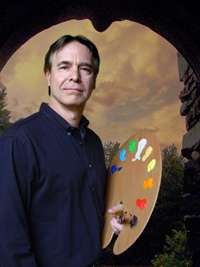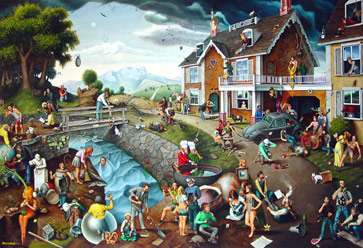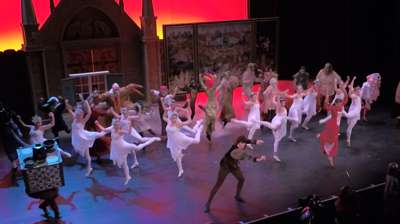T. E. Breitenbach
Thomas E. Breitenbach (born July 29, 1951 in Queens, New York)[1] is a self-taught American artist best known for his painting Proverbidioms, a raucous and comical depiction of over 300 common proverbs and clichés. He also collaborated with Jim Morrison of The Doors, shortly before Morrison's death, on a painting intended for use on his An American Prayer album. Breitenbach studied architecture and fine arts (in an independent study program) at the University of Notre Dame, before leaving to become the youngest person to receive the Rome Prize Fellowship in visual arts. Breitenbach declined the second year of the fellowship and, inspired by the castles and museums of Europe, returned home determined to build a castle-studio to house his art and eventually become a museum. During the planning stages he painted Proverbidioms and later published it.
T. E. Breitenbach | |
|---|---|
 | |
| Born | Thomas E. Breitenbach July 29, 1951 Queens, New York, United States |
| Nationality | American |
| Education | Self-taught |
| Known for | Painting |
| Awards | Rome Prize Fellowship |
Periods and technique
Breitenbach’s earliest works are dark allegories spurred by his vision of man’s nature as being hopelessly irrational and violent. Influenced by Carl Jung, Breitenbach's subjects are constructed using archetypal symbols and are intended to provoke strong emotional responses from the observer.[2] Breitenbach emphasizes that these paintings are not surrealism, because surrealists tend to use personal and dream symbols which are not an effective form of language. He was awarded the Rome Prize in 1973 by the Society of Fellows of the American Academy in Rome in the visual arts category.[3]

In 1974, Breitenbach started work on a painting of contemporary proverbs, idioms, and clichés, after feeling challenged by a review of Pieter Bruegel's sixteenth-century painting of Dutch proverbs, Netherlandish Proverbs, suggesting that language was particularly colorful "back then".[4] This became Proverbidioms, his best-known work, completed in 1975 at the age of 24. This large painting illustrates over 300 common expressions like "You are what you eat", "butterflies in the stomach", "the rat race", and so on, and identifying the sayings became a kind of puzzle for his audience.[5] Proverbidioms has been turned into a poster, jigsaw puzzle, and appeared on the TV show Beverly Hills, 90210 in a few episodes.[5]
Breitenbach's extensive use of humor in this work was a major departure from the mood of his early paintings, though social commentary is still present in Proverbidioms, for example in the sewer pipe running into the river, and the white female vs. black male representing "I've got a bone to pick with you," a reference to both the women's and the civil rights movements. Breitenbach further maintains that much is revealed about man’s nature through the literal painting of his expressions. Therefore, the artist did not shy away from placing wise expressions such as "Don't put all your eggs in one basket", and "Many hands make light work", alongside crude ones like, "flat as a board" and "knockers". In 1980 the artist began publishing posters of this and other works. These became quite popular both for their entertainment value and for use in education.
After his marriage in 1979 and the birth of his first child, Breitenbach's paintings became particularly colorful. He blames this on the ultra-bright toys that were strewn about the house, but his painting technique also enhances this. He uses traditional Flemish oil-glazes, a meticulous process.[2] Light penetrates the transparent paint layers, striking the pure-white gesso panels (made of chalk and glue) and reflecting back at the viewer, creating a luminous effect.
Breitenbach went on to paint a dozen more such humorous puzzle paintings, often with specific themes (see "Major Works", below).
Jim Morrison triptych

In the fall of 1970, while still at college, Breitenbach sent pictures of his artwork to Jim Morrison and offered to paint an album cover.[5] Morrison accepted and sent Breitenbach his ideas for a triptych, along with two autographed, private editions of his poetry. Morrison liked the finished painting and asked if he could use it on an album of poetry he was working on. This was his An American Prayer album published seven years after his death. Unfortunately, the album’s producers were not aware of Morrison’s intention to use the painting.[6]
Building a castle
In 1976, Breitenbach began constructing by hand a small castle, on land given him by his father. The first stage was an octagon and tower, inspired by the Victorian-era book The Octagon House by Orson Fowler.[2] Fowler recommended the octagon as an ideal and economical shape for a house. For Breitenbach, it was also suited to a castle. In 1987 he added a large studio addition. Breitenbach quarried stones (some as long as 12 feet) from a nearby creek, cut trees for lumber, and salvaged a collapsing carriage barn for beams and siding.[5] He forged iron hardware, made leaded-glass windows, furniture, carvings, tilework, and a fresco, so that many of the arts would be represented. He intends to leave the castle and paintings behind as a museum. He would hire college students during the summer to help him. One of those, Dan Root of Edmeston NY, remembers where on rainy days the thrifty castle builder would have his help straighten out nails that were previously used in the construction of the home made scaffold systems.
Hieronymus, A Musical Fantasy

Hieronymus, A Musical Fantasy is an original musical with music, lyrics, and book by Breitenbach about Hieronymus Bosch "An artist with a 'too-large' imagination". The musical was staged and made its world premiere at Proctors Theater in Schenectady New York in 2016 for the purpose of filming it for public television.[7][8]
Other art forms
Breitenbach has written an illustrated fantasy novel and a book of painting secrets, designed fonts, composed film music, and written musicals, including Hieronymus, A Musical Fantasy a partly autobiographical story about medieval fantasy artist Hieronymus Bosch and his over-active imagination.[5]
List of major works
Allegorical paintings
Puzzle paintings
References
- U.S. Public Records Index, Vols 1 & 2 (Provo, UT: Ancestry.com Operations, Inc.), 2010.
- Scherbeck, Bastian (2007). "The Proverb World of Thom E. Breitenbach: An Analysis of Proverbidioms" (PDF). Proverbium Yearbook of International Scholarship. 24: 35–367. Retrieved 2009-02-04.
- "Directory by Year Index: 1971-1980". Society of Fellows of the American Academy in Rome. Archived from the original on 2008-07-19. Retrieved 2008-11-22.
- Mieder, Wolfgang (2008). Proverbs Speak Louder Than Words. The University of Vermont. pp 267-269. ISBN 978-1-4331-0378-0
- Pinkney, Barbara (March 4, 2005). "Artist thrives by trying new forms of expression". The Business Review. Retrieved 2008-11-22.
- Silva, Rui (2008) Contigo Torno-Me Real. Edições Afrontamento. ISBN 978-972-36-0950-9
- Hale-Spencer, Melissa (August 10, 2016). "One artist's vision embraces a community - Breitenbach produces his musical". Altamont Enterprise.
- Buell, Bill (August 17, 2016). "Young actors lead way in musical fantasy". The Daily Gazette.
External links
- T. E. Breitenbach's Website
- The artist's poster shop
- Hieronymus, A Musical Fantasy Official Website
- Hieronymus, A Musical Fantasy Trailers
- Proverbidioms, The Art of T. E. Breitenbach - A Documentary
- A Catalogue Raisonné
- An archive of articles, films, and other Breitenbach memorabilia
- A History of Proverbidioms
- The Jim Morrison Triptych
- Watch Breitenbach's Hieronymus Bosch Musical on WMHT
- A behind-the-scenes feature produced by WMHT for AHA, titled "The Making of T. E. Breitenbach's Hieronymus"